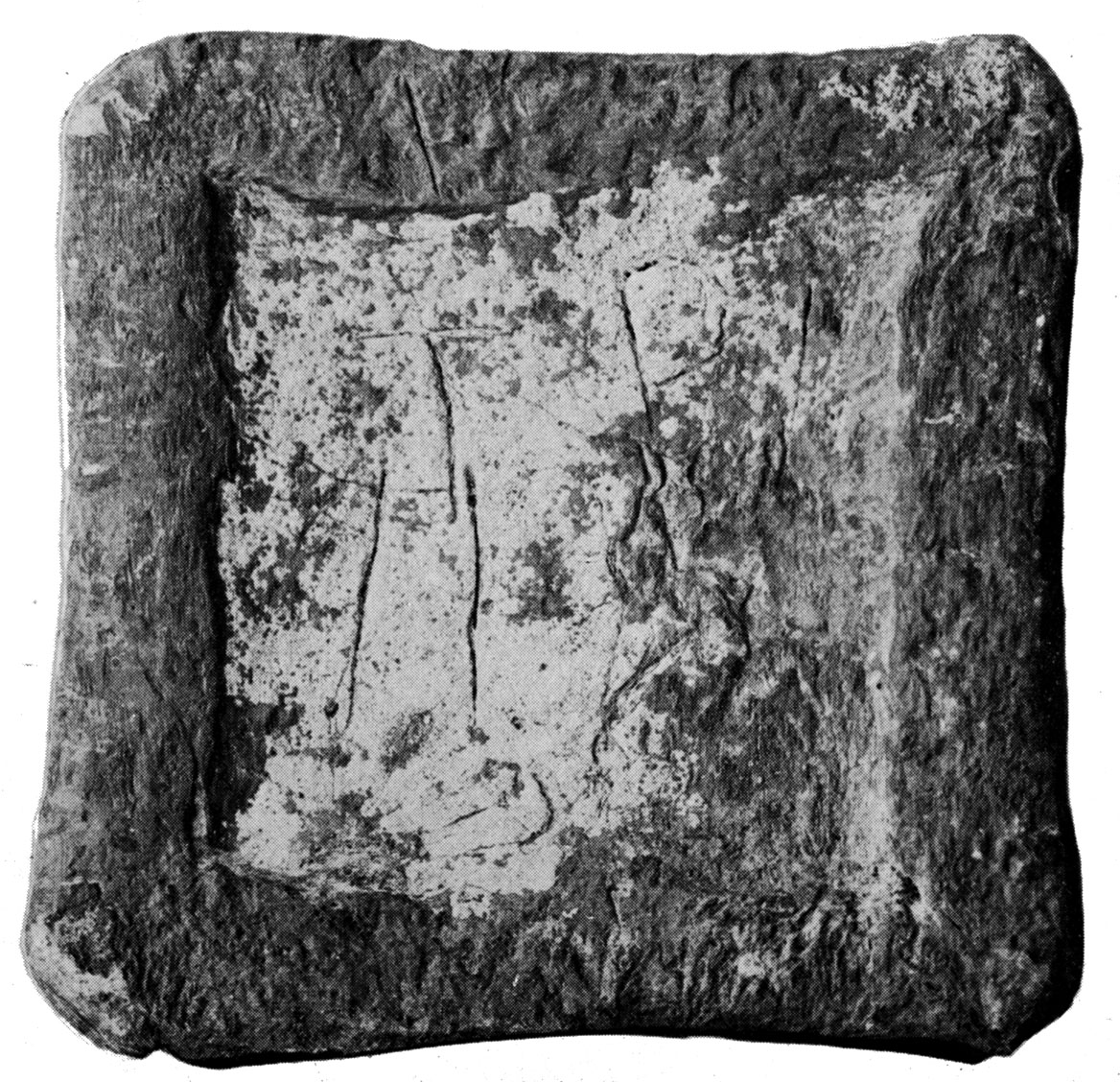
-
Copyright credit: Robinson 1941

-
Copyright credit: Robinson 1941

-
Copyright credit: BibleLandPictures.com

ARCHAEOLOGICAL DESCRIPTION OF THE WEIGHT
Authority
Mint
Denomination
3 Minas
Material
Lead
Manufacture
Cast
Shape
Square
Length
8.80 cm
Width
8.80 cm
Height
2.20 cm
Metrology
| Mass (g) | Mass (grain) | Date of measurement | Reference | fragmented | cleaned | reference weight |
|---|---|---|---|---|---|---|
| 1255.60 | - | - | Robinson 1941 | No | No | Yes |
| 1255.30 | - | April 19, 2018 | L. Delanaye | No | No | No |
Iconography
| Symbol | Technique | Direction | Position | Number | Synecdoche |
|---|
Wear
Worn
Corrosion
Heavily corroded
Handle
No
Suspension hole
No
Recarved mould
No
Recarved weight
No
Intentionally destroyed
No
Archaeological description
Square lead weight, measuring 88x88x18/22 mm and weighing 1255,3 grammes, with rounded corners ; worn and verry corroded. Inscriptions on both sides. On the obverse, frame in relief, incised letters ΤΡΙ (not very legible). On the reverse, incised ΤΡΜΝ|ΑΟΝ ; multiple little strokes. Sides slightly hollowed, edges and corners rounded. Notch on the inferior side, visible on the reverse's right inferior corner. Height without relief: 1,8 cm.
Robinson 1941: Inv. 31.402. Lead weight. L. 0.088 m., W. 0.091 m., Th. 0.024 m., Weight 1255,6 grammes. Approximately square. Sides slightly concave. Deep lines incised lengthwise on narrow sides. A long shallow gouge has been taken out of each side. The bottom has been hollowed out roughly to a depth of ca. 0.005 m., leaving a broad raised margin around the edge, averaging ca. 0.015 m. in width. Both obverse and reverse are inscribed. On the obverse in letters neatly scratched, 0.01 m.-0.014 m. high (the circle of the rho and the omicron, only 0.006 m. in diameter, were cut with a circular chisel). ΤΡΜΝΑΟΝOn the reverse, within the square cavity the letters are rudely scratched, 0.015 m.-0.022 m. high.ΤΡΙΙΙThe crossbar between the two uprights in the second line is certainly accidental but perhaps M was intended, and we have τριμ as an abbreviation for τρ(ι)μνα(ῖ)ον on the obverse. Possibly the abbreviation is TPI and the other marks are not meant for letters, but are scratches. TPI is, however, the abbreviation on an unpublished lead weight from Corinth for τριτημόριον. This would certainly seem to be a weight of three minas on the Euboic standard of about 420 grammes to a mina, though the inscription is new. Ἡμιμναῖον, δίμνουν, διμνα(ῖον) occur, and τρ(ι)μνάον is the Macedonian form for τρ(ι)μνα(ῖ)ον, equivalent to τρ(ί)μνουν. So we have here a standard of a mina as about 418.51 grammes. On that basis the πέλεκυς [cf. Robinson 1941, n. 2382] would also be equivalent to three minas or more. Lead becomes heavier when left in the ground and many of the lead weights have lost weight through wear and tear, so that it is impossible to attain exact accuracy from those preserved.
Robinson 1941: Inv. 31.402. Lead weight. L. 0.088 m., W. 0.091 m., Th. 0.024 m., Weight 1255,6 grammes. Approximately square. Sides slightly concave. Deep lines incised lengthwise on narrow sides. A long shallow gouge has been taken out of each side. The bottom has been hollowed out roughly to a depth of ca. 0.005 m., leaving a broad raised margin around the edge, averaging ca. 0.015 m. in width. Both obverse and reverse are inscribed. On the obverse in letters neatly scratched, 0.01 m.-0.014 m. high (the circle of the rho and the omicron, only 0.006 m. in diameter, were cut with a circular chisel). ΤΡΜΝΑΟΝOn the reverse, within the square cavity the letters are rudely scratched, 0.015 m.-0.022 m. high.ΤΡΙΙΙThe crossbar between the two uprights in the second line is certainly accidental but perhaps M was intended, and we have τριμ as an abbreviation for τρ(ι)μνα(ῖ)ον on the obverse. Possibly the abbreviation is TPI and the other marks are not meant for letters, but are scratches. TPI is, however, the abbreviation on an unpublished lead weight from Corinth for τριτημόριον. This would certainly seem to be a weight of three minas on the Euboic standard of about 420 grammes to a mina, though the inscription is new. Ἡμιμναῖον, δίμνουν, διμνα(ῖον) occur, and τρ(ι)μνάον is the Macedonian form for τρ(ι)μνα(ῖ)ον, equivalent to τρ(ί)μνουν. So we have here a standard of a mina as about 418.51 grammes. On that basis the πέλεκυς [cf. Robinson 1941, n. 2382] would also be equivalent to three minas or more. Lead becomes heavier when left in the ground and many of the lead weights have lost weight through wear and tear, so that it is impossible to attain exact accuracy from those preserved.
Autopsy
Yes
INSCRIPTION
| Language | Technique | Legend type |
|---|---|---|
| Greek | Incised | Denomination |
Fac simile
ΤΡΜΝ | ΑΟΝ - ΤΡΙ | ΙΙ
Edition
Τρ(ι)μνα(ῖ)ον.
Monogram
ARCHAEOLOGICAL CONTEXT
Findspot (region)
Greece: Chalkidiki
Findspot (site)
Olynthus
context
Robinson 1941: From House A vii 9, room d.
CIRCUMSTANCES OF ACQUISITION
Region
City
Date of first acquisition
circumstances
DATING OF THE WEIGHT
Curatorial Section
GREEK
Time frame
FROM
-500
TO
-350
Comments on Chronology
COLLECTION HISTORY
Collection
| Name | Date of acquisition | Inventory number |
|---|---|---|
| Numismatic Museum (Athens) - Olynthos | None | 31.402 |
Bibliography
| Reference | Page/Column | Reference (number) | Plate / Figure | Comment |
|---|---|---|---|---|
| Robinson 1941 | 449–451 | 2383 | CXXXIX | None |
| Tekin 2016a | 52;179 | None | pl. 5/ fig. 30 | None |
VARIA